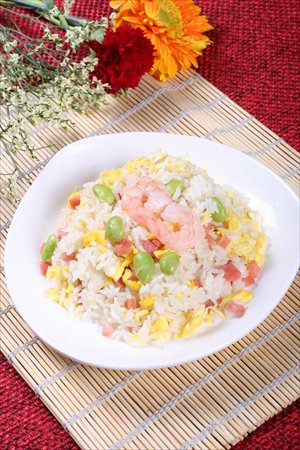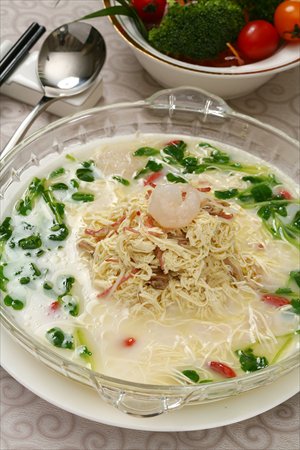Flavors of the season


When this time of year rolls around, people quote a line from Chinese poet Li Bai to treat the seasonal travel itch: "Head to Yangzhou in springtime." This city in Jiangsu Province is known not only for its landscape, but also for its cuisine, Huaiyang Cuisine, the food of my hometown which is not far from Yangzhou.
I have lived in Beijing for 12 years, and though I hail from this well-known culinary region, here in the capital I generally live on waimai, or takeout, and go out to eat a lot, which means that most of my food is Sichuanese. Sichuan dishes seem to be served in every restaurant in Beijing.
As cases of H7N9 bird flu pile up, more of my dining companions do not want to order chicken, or any other type of meat for that matter. To me, an avid meat lover, this is simply unacceptable.
I do know how to cook. One of my greatest pleasures as a child was when my father prepared lunch on the weekends, partly because it meant a fun break from my homework when I would act as his "assistant."
For those itching for culinary adventures in the kitchen, these Huaiyang dishes may fit the bill. The cuisine is just as well known as Sichuan cooking, but its flavors are more delicate, making for a lovely respite from the spicy fare that ravages your tongue.
Yangzhou Chaofan
Yangzhou Fried Rice, probably one of the best-known chaofan in China, may look quite simple, but it's full of flavor. Even the thought of it makes my mouth water. Years ago, I saw a film where a master chef asked those competing to become his apprentice, and therefore the next master, to make Yangzhou Chaofan. It really is that important.
When the finished product is served at the table, the appearance alone is a reward for the preparation of such rich ingredients. The crystalline grains of rice are wrapped with egg, decorated with colorful ingredients like red diced ham, green peas and orange carrots.
Ingredients:
-500 grams of rice, prepared a day in advance and refrigerated overnight to ensure that it separates into grains.
-3 eggs
-10 grams Jinhua ham
-One medium carrot
-50 grams half-cooked, shelled shrimp
-20 grams shiitake mushrooms
-10 grams cooked peas
-30 grams winter bamboo shoots
-3 grams salt
-5 grams chopped scallions.
Steps:
1. Place shrimp in a marinade of salt, cornstarch and vegetable oil for ten minutes.
2. Dice the ham, carrot, shiitake mushrooms and bamboo shoots. In a separate bowl, whisk the eggs.
3. Add eggs and a small spoonful of vegetable oil together into the rice and mix thoroughly to ensure that every grain is wrapped in the egg mixture.
4. Bring a pot of water to boil and put the ham, carrot, mushrooms, bamboo shoots and peas into the water for one minute. Drain and set aside.
5. Heat a wok and add two big spoonfuls of oil. When small bubbles rise in the oil, add shrimp and stir-fry until fully cooked. Remove shrimp and clean wok thoroughly.
6. Heat the wok and add enough oil to coat the entire interior after rolling around. When oil is heated, add the rice mixture and stir-fry until eggs turn yellow.
7. Add ham and accompanying vegetables and stir-fry for another three minutes. Add the fried shrimp and stir well before adding a sprinkling of scallions. Turn off flame and serve immediately.
Dazhu Gansi
You may be wondering what the hell gansi is. Think of doufu si, or shredded tofu, but finer and softer. One fascinating aspect of Huaiyang Cuisine is that the names of many dishes do not necessarily give insight into their ingredients. The most interesting example is Shizitou, or Lion's Head. There is nothing lion-ish about the dish, which is in fact a large meatball. Dazhu Gansi, or boiled tofu strips, is a common part of Huaiyang tables.
When shopping for the main ingredient, dried tofu, you will find two kinds in the market that are almost the same in shape but different in color. Chagan is dark, and the type you need for this recipe, xianggan, (fragrant dried tofu), is white.
Ingredients:
-200 grams xianggan
-20 grams shelled raw shrimp
-15 grams Jinhua ham
-25 grams winter bamboo shoots
-5 grams shrimp eggs
-50 grams cooked chicken breast, cut into thin strips
-10 grams pea sprouts
-300 milliliters chicken stock
-10 grams salt.
Steps:
1. Cut the tofu into julienne strips. If you prefer, you can buy pre-shredded tofu at the market. Using a sieve, immerse tofu in a pot of boiling water for one minute. Remove, drain, then submerge another minute. Drain.
2. Heat a wok and add oil. Stir-fry shrimp until fully cooked. Set aside.
3. Pour chicken broth into a pot. Place tofu shreds on one side, and chicken, ham, shrimp eggs and bamboo shoots on the other side. Bring to a boil and simmer for 15 minutes until soup is thick. Sprinkle evenly with salt and cover. Simmer 5 more minutes.
4. Place tofu in the bottom of a serving bowl and pile with items on the other side of the pot. Top with shrimp and pea sprouts and pour broth into bowl. Serve immediately.
Dining out
While Huaiyang Cuisine is known for focusing more on presentation than taste, the flavors that come out of its recipes are still absolutely divine. For those who wish to partake without dirtying their own kitchen, it might be preferable to find a restaurant that serves Huaiyang Cuisine.
In the home of this cooking style, Yangzhou offers numerous choices from the well-known Fuchun Restaurant to low-budget options like Huayuanchalou, Laosubei Restaurant and Yiyuan Restaurant. In Beijing, Jiangsu locals have opened many joints like Yanchunlou, Huaiyangfu, Tongchunyuan and Wudirenjia. Shanghai offers even more options like Suzhezonghui, New World Restaurant, Yangzhou Restaurant and Nanling Restaurant.